We can have a political discussion about Amazon.com at another time. Right now, I feel grateful to the mega-company because, unlike most major publishers, Amazon has found value in providing access for readers to the work of past mystery authors. When I walk into a bookstore – and these days, that is getting harder and harder to do (no, I won’t grumble about online sellers now! I’m making another point entirely) – and turn to the mystery section, what classic mysteries grace the shelves? There’s Agatha Christie, of course; the larger stores remain well-stocked with her books. There might be a couple of titles by Sayers or Stout, as well as some of the better-known hard-boiled authors: Chandler, Hammett, Ross McDonald. But of Allingham, Marsh, Carr and Queen there is not a whiff. Gone are the days when these authors are regularly re-issued. I think the last major release of Queen titles was in the 1970’s with those wonderfully awful sexy girls on the cover; even then, perhaps, the publisher didn’t have enough faith that the Queen name alone would sell those books.
I haven’t seen a John Dickson Carr novel in a first-hand bookstore in twenty years! Fortunately, one of the public libraries in my county has preserved hundreds of mystery novels from the 1920’s through 1940’s on their shelves – even the humdrums, like Henry Wade and the Coles – for which I’m most grateful.
Perhaps Amazon looked at its statistical data and foresaw is a hungry market for classic mysteries. Perhaps they’ve taken note of the efforts of people like Curtis Evans and Martin Edwards, writers who have promoted the study and release of long forgotten authors like Ianthe Jerrold, Freeman Wills Croft, and Annie Haynes. More and more titles are popping up in actual book form to delight Golden Age mystery fans, and Amazon is contributing to this potential renaissance by releasing a whole slew of authors on their Kindle format at very reasonable prices!
Which is how I came to discover Helen McCloy. A fellow mystery lover over at the Golden Age of Detection group on Facebook sounded the call about a month ago: all of McCloy’s titles were on sale for $2.99 on Kindle. I popped over to Amazon and purchased five titles because I had heard good things about McCloy from members of the group.
After reading two of the titles, all I can say is: how right they were!
Despite a career that spanned 42 years, and despite being the first female president and one of the founding members of the Mystery Writers of America, McCloy’s books seemed to have failed to achieve first tier status. I say this only because you can find Christie and Sayers in stores and libraries, but one would be hard-pressed to find any large collection of McCloy’s work in these places. This is a shame because she was a terrific writer, in some ways every bit as good as the Queens. She was fairly prolific, publishing twenty eight novels and many short stories between 1938 and 1980. Thirteen of her books feature Dr. Basil Willing, a psychiatrist, while fifteen are non-series mysteries.
I can’t create a credible discussion of the author’s entire career based on just two novels; I can only give an impression. I read Through a Glass, Darkly (1950), the eighth Basil Willing mystery and the book most people consider to be McCloy’s best, and Mr. Splitfoot (1968), the second to last Willing novel and one that H.R.F. Keating listed in 1987 as one of the 100 best crime and mystery books ever published!
Both of these novels share a few things in common, elements that are part of McCloy’s strength as a writer. They are beautifully atmospheric! In a short space – and these books are models of brevity – McCloy can evoke a wonderful sense of place and imbue it with a heavy layer of suspense, even horror. It may be just a coincidence, but both books conjure up a strong element of the supernatural which, like the best of John Dickson Carr, the author is able to sustain until the very end when all is revealed to be the work of a human agency.
Through a Glass, Darkly deals with the myth of the doppelganger, that double of ourselves who lurks in the shadows and whose appearance signals misfortune or death. Faustina Crayle, a timid young teacher, has been fired from her jobs at a private girls’ school. The headmistress will give no reason for the termination, and Faustina’s only friend, another teacher named Gisela, turns to her boyfriend, Dr. Basil Willing, to get some satisfaction for Faustina. What Willing learns, though, is impossible: the students and faculty have seemingly been haunted by Faustina’s double, sometimes in places where Faustina cannot have been and sometimes in view of the woman herself. As evidence mounts, and murder rears its ugly head, Willing, ever the realist seems to be the only member of this cast of characters who refuses to blame the unfortunate events on a ghost!
Mr. Splitfoot is another name for the Devil, and this late entry in the series conjures up the power of pure evil as Willing and Gisela, now his wife, become stranded in upstate New York and end up the unwilling guests at a house party in a snowbound farmhouse deep in the woods. There is a room upstairs where legend states that those who spend the night never awaken in the morning. Did witches once dwell on this property? It would seem so, based on the spooky events of this fateful evening: first, a child’s prank goes awry with devilish undertones, and then the house’s owner accepts a bet that he can survive one night in the room. His fellow housemates leave the bedroom door open so that he won’t give in to panic. There’s even a bell to ring in case something untoward happens. A short time later, the bell tolls, the others run in and . . . well, what do you think? As Willing investigates what will turn out to be the first murder, he discovers secrets among the guests and within the house itself. Could the murdered man’s garbled last words hold the key to the truth?
Helen McCloy
McCloy isn’t a plotter in the Christie vein, but boy, she beats the hell out of Dame Agatha in terms of atmosphere, characterization, and place. Yes, in both cases there is a mystery to solve, with clues and suspects, and Willing sorts it all out in the end. To me, the solutions are the weakest part of both books. Maybe it’s because McCloy does such a great job of inspiring uncertainty as to whether or not supernatural forces are involved that, when the solution is revealed, the reality seems like a letdown. Fortunately, this happens right at the end. In Darkly, the sense of horror permeates the writing right up to the last page of the penultimate chapter. I didn’t guess the ending, but then there wasn’t much chance of that given the slightness of the clues. But the solution was a good one, if based too much on luck and coincidence, and the final banter between Willing and the killer brings back some of that earlier psychic chill right at the end.
I’m terrible with impossible crimes and locked room mysteries, and Mr. Splitfoot fits into that sub-genre. However, here I guessed the solution almost immediately, and I figure most long time readers of “locked room” mysteries will also do so. The middle part of this book, which details the investigation, tends to drag a little bit. The characterization in this book isn’t as strong as in Through a Glass, Darkly, except for the wonderful portrait of a little girl, and the supernatural element is pretty much discarded in the light of day. However, the excitement revs up at the climax, where several characters face true danger before the truth can be revealed.
It’s always exciting to find an author with enough books to keep you busy for a long while. When I return to Helen McCloy – I still have Cue for Murder, The Slayer and the Slain, and Alias Basil Willing on my Kindle queue, and many more where that came from – I know I will be in for another round of excellent set-ups and fine atmospheric writing.

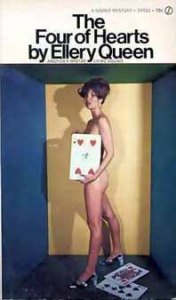
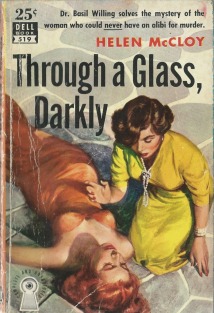
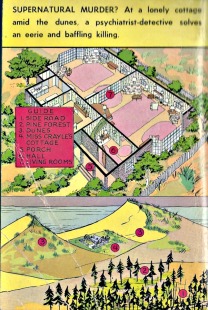
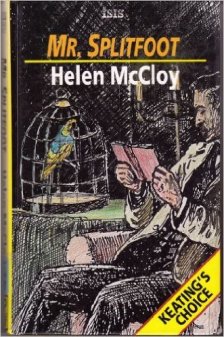
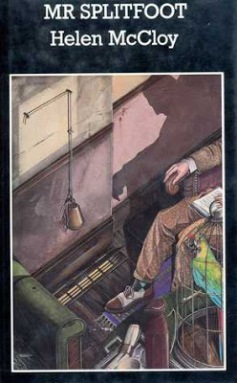
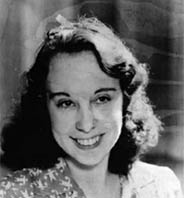

These are the two McCloys I’ve read, too, and there’s a lot to enjoy in them – you’re absolutely right about her atmosphere, there’s a real pervading sense of doom throughout …Darkly which I liked a lot more than the solution (which I found a little…fortutitous, let’s say). Splitfoot is another fabulous piece of atmosphere-work, and even though most of the characters speak with exactly the same voice it really does out-Christie Christie in many regards (though Christie’s plot would have had a lot more flourishes in her classic era!). The Slayer and the Slain is supposedly a masterpiece, so that’s where I’m heaing next with her…I look forward to hearing of your own adventures…!
LikeLiked by 1 person
Nice reviews! I also availed myself of the sale to pick up these 2 novels in their Kindle editions, as well as ALIAS BASIL WILLING…though I have yet to read them. I appreciate your whetting my appetite for these books without giving anything important away. I esp. agree with your sentiments regarding the lack of availability of Golden Age Detective novels in the big chain bookstores, and the joy in finding a new-to-you author with lots of material left for future reading pleasure (I’ve only recently got into John Dickson Carr and Gladys Mitchell, and have greatly enjoyed slowly digging into their back catalog.)
LikeLiked by 1 person
I hear you, Jeff. I can only re-read Christie so many times! There are still some Carrs I have yet to read, mostly the Henry Merrivales, which many folks say are his best!
LikeLike
She really was a very good writer and I like her readiness to vary her approach.
LikeLike
Both favorites of mine!
LikeLike
Pingback: THE DARKER REACHES: Helen McCloy’s The Slayer and the Slain | ahsweetmysteryblog
Pingback: PUZZLING PUDDLES: Paul Halter’s The Madman’s Room | ahsweetmysteryblog
Pingback: Through a Glass, Darkly (1950) by Helen McCloy – Dead Yesterday
Pingback: Mr. Splitfoot (1968) by Helen McCloy – Dead Yesterday
Pingback: HOW HELEN MCCLOY HELPED RID ME OF MY OCD | ahsweetmysteryblog
Pingback: My Book Notes: Through a Glass, Darkly, 1950 (Dr Basil Willing # 8) by Helen McCloy – A Crime is Afoot
Pingback: My Book Notes: Mr Splitfoot, 1968 (Dr. Basil Willing #12) by Helen McCloy – A Crime is Afoot
Pingback: Mr. Splitfoot - Helen McCloy (1968) - Playing Detective